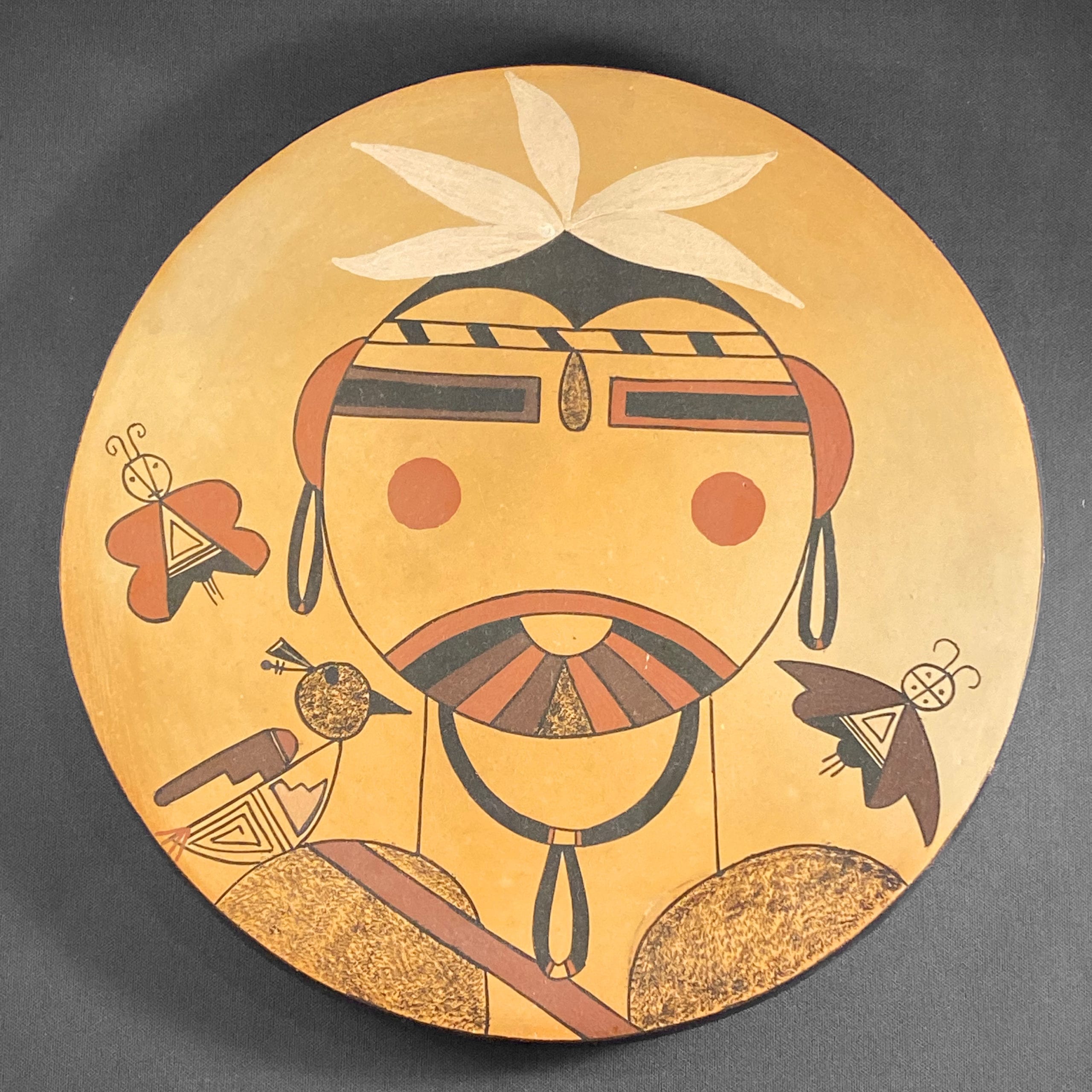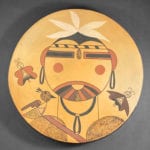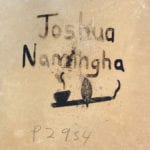This collection has 19th, 20th and 21st century examples of the Polik’Mana image displayed on this plate (see “Kachina Design” in Category Listing). The elements of design in these renditions are strikingly consistent across time, varying only by the skill of the artist. While still incorporating these elements, this rendition by Joshua is simpler and looser than other representations of the Polik Mana.
Born in 2000, Joshua Namingha is a son of noted potters Les and Jocelyn Namingha. Al Hayes, from whom I purchased plate 2019-03, believes it was made in 2014 when Joshua would have been about 21 years old. Joshua’s father Les seems to have always experimented with more abstract designs and now does innovative, cutting-edge kiln-fired pottery painted using acrylic paint. (See Artist List.) Les painted his version of the Polik’Mana on cloth that was then mounted on a clay tile and is part of this collection (2016-02). Yet even given his innovative style, Les’ rendition of this Mana is very close to the traditional form. In contrast, son Joshua paints in more of a more casual folk art style using paints and techniques that are part of the Sikyatki Revival tradition.
Plate 2019-03 is very shallow, almost flat. It is quite thick and when struck by a finger emits a dull “thunk” indicative of a low-temperature outdoor firing. The tan background is even with no noticable blushing.
Although drawn more casually. Joshua’s design has all of the distinctive characteristics of the Polik’Mana. You might remember Nampeyo’s 1890’s tile (2014-10) for comparison:

The face and feather headdress of the Polik’Man are traditionally shown oversize in comparison with other parts of her body. On Nampeyo’s tile 2014-10 they cover 61% of the diameter; on Joshua’s plate they occupy 70% of the plate’s diameter. Most distinctive is the Mana’s “Darth Vader” like mouth, here represented as a red arch over an unpainted half circle emanating 9 black, red, maroon and stippled rays. On her cheeks are two red dots, indicating her female gender. (In spite of being a Mana, this figure also dances with striped triangles on its cheeks, indication its male persona, as on the Nampeyo tile.) Above are two slit eyes with black centers outlined in red (right eye) and brown (left eye). Above is a striped headband; at its center hangs a stippled pendant. Above the headband are two unpainted half circles, perhaps eyebrows (?). At the peak of the head a black bat-shaped form completes the head. With slight variation all of these elements are shared with the 1890’s Nampeyo tile.
All other renditions of the Polik Mana in this collection carry elaborate tabula headdresses. Here Joshua has substituted a plume of 5 white feathers.
Untraditionally Joshua raises the head on a long visible neck. Traditionally he embellishes the neck with a necklace (here black with an accent loop and two light-colored beads). Stippled shoulders are crossed by a bandana, also typical elements for this design.
I have never before seen the Polik’Mana accompanied by wildlife, here two butterflies and a bird. The butterflies are different, perhaps indicating gender distinction. The one above the Mana’s right shoulder has bimodal red wings, a triangular body core and a black tail. Its face is distinguished by a “V” mark, eyes and a mouth and the head sprouts curled antennae. The butterfly above her left shoulder has more triangular maroon wings and the same core and tail as the other butterfly. Its face marked with a cross and dots in the four quadrants and the head also sprouting curled antennae.
The stylized bird on the Mana’s right shoulder is perhaps the folkiest image on the plate, the body a half circle, its breast displaying a stepped rain cloud, its rear a triangular fret with seven right turns. This fret was also found on prehistoric pottery from the western mound at Awatovi (Smith, 1971:153, fig 100c). Its tail has a spray of 5 yellow/tan lines. I remember an Oldsmobile hood ornament that looked a lot like this bird’s wing: bullet-nosed, stepped and sleek. The head is a perfect circle with a solid black circle for an eye and a triangular black beak. The topknot consists of both a single large feather and a small stem with crossing lines and a circle (flower? feather?) at the end.
The underside of the plate is painted with two concentric rings of 16 rectangles. Every other rectangle is subdivided into two small squares. Each of these smaller squares contains a set of two triangular elements with their narrow side arched to leave two points. Thus two of these pairs (four triangular forms) fill the original larger rectangle. This triangular pattern is repeated eight times in the outer circle of design. Interspersed between are eight rectangles painted solid maroon.
The inner ring of design on the bottom has a similar layout, except that the triangular elements point in the opposite direction and the space between the sets of four triangles is filled with a rectangle stippled with the maroon paint.
The plate is signed “Joshua Namingha and the overlaid symbols of what I believe to be the tabacco clan: a pipe and a leaf of tobacco.
Plate 2019-03 is painted with skill and a style that makes me smile. This is the only pot by Joshua that I have seen. Many skilled younger pueblo potters pot for only a few years and then move on to a different way of earning a living.





